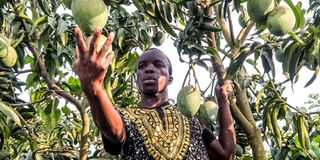Here’s how to curb the deadly mango fruit fly

A farmer tends to his mangoes. NMG PHOTO
The larvae or maggots develop in the flesh of untreated fruits by digging tunnels that provide opportunities for secondary infection when the larvae emerges from the fruit. When the eggs hatch, the maggots feed on the fruit flesh making gullies.
Mangoes are one of the most important fruits in the country the other being bananas, pineapples, oranges, jackfruits and watermelon.
Production of the fruit has been on the rise as demand increases, with the market stretching beyond our borders.
But pests such as fruit fly and mango weevil are among the worst enemies, with diseases ranging from anthracnose to powdery mildew.
Of the pests, the fruit fly, which also affects vegetables and avocadoes, among other fruits, is the most devastating. The invasive fly (Bactrocera invadens) was first detected in 2003.
The fly damages up to 80 per cent of a fruit, although this mainly depends on the locality, cultivar and season.
There are four fruit fly species namely Bactrocera invadens, Ceratitis rosa, Ceratitis capitata and Ceratitis cosyra. Bactrocera invadens is the most prevalent in East Africa especially Uganda and Kenya.
Life cycle of a fruit fly
A female fruit fly can live for up to six months. During this period, it lays 500 to 800 eggs inside the fruit, making it hard to eliminate the insect with pesticides. The eggs hatch between two to four days into larvae, which feeds on the fruit pulp and takes a week to mature.
Damaged fruits normally drop on the ground, where the larvae exits to pupate in the soil, taking only a week, before adult fruit flies emerge to begin the cycle again.
How the fly penetrates the fruit
The female fly implants its eggs into young fruits of the host plant. The larvae or maggots develop in the flesh of untreated fruits by digging tunnels that provide opportunities for secondary infection when the larvae emerges from the fruit. The growth of larvae accelerates maturation of the fruit, which detaches and falls to the ground.
The larvae leaves the fruit and the pupae develops in the top few inches of the soil. After it emerges from the soil, it starts looking for the nourishment it needs to reach sexual maturity, couple and lay eggs.
Damage
The flies puncture the fruit skin to lay eggs. During this process, bacteria from the intestinal flora of the fly are introduced into the fruit causing rotting of the tissues surrounding the egg.
When the eggs hatch, the maggots feed on the fruit flesh making gullies. These provide entry for pathogens and increase the decaying of the fruit making them unfit for human consumption. The fruit then falls to the ground just before the maggots pupate.
Control
If the fly population is too large, there is no control method that will be effective and profitable. However, here are preventive measures.
Maintain high sanitation in the orchard to interrupt the development of the fly.
Remove the dropped fruits every day and kill the maggots by burning the mango, burying at least two feet in the ground to prevent emerging adult flies from reaching the soil surface or enclosing them in black plastic bags and then exposing in the sun for a few hours to kill the maggots.
Avoid planting or keeping host plants that include citrus, guava, papaya and melon on the farm. The plants lead to the development of a large population of fruit flies at the start of the mango harvesting season.
Do not have untended orchards or wild trees near a cultivated plot. The farm must also be carefully weeded as this will make it easy to see and pick up fallen fruits.
Use traps to determine the population density of the fruit flies. This will help you know the control measure to take.
Biological control by use of Metarhizium anisopliae, which is a fungus occurring naturally in the soil and is applied to kill the pupae, helps.
Harvested fruits should be treated with hot water at 48 degrees Celsius for six to seven minutes.
Chemical control of adult fruit flies in orchards should be done weekly using bait foodstuff, usually mixed with a poison spray - protein hydrozylate or molasses mixed with malathion, trichlorphon, fenitrothion or fenthion.
The bait is applied in large drops at a rate of 200 to 1,000 ml per tree. It is not necessary to wet the whole tree; only part of the foliage needs to be covered.
Symptoms
Attacked fruit usually shows punctures (made by females while laying eggs) that often lead to necrosis. Small holes are visible on the produce when the maggot leaves the fruit. The affected part becomes soft and colours prematurely. Maggots of fruit flies drop out of mango fruit to pupate.




